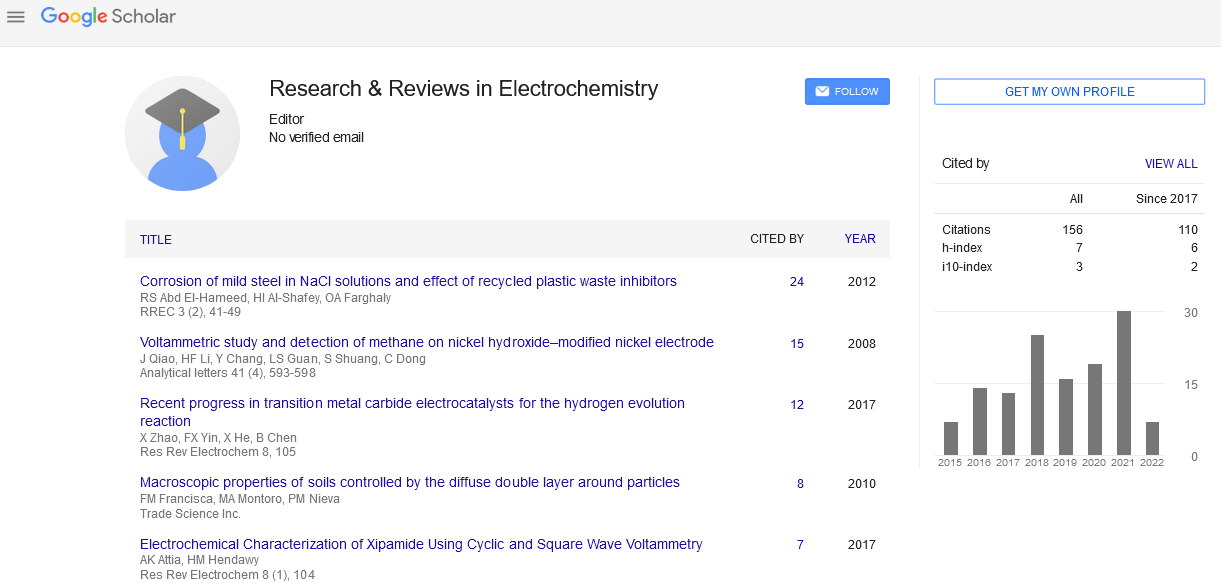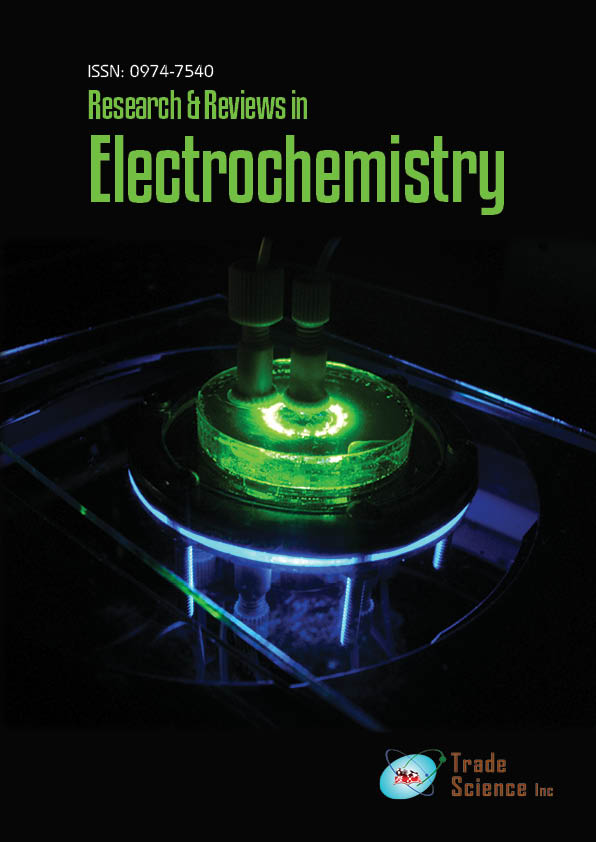Short commentary
, Volume: 12( 2) DOI: 10.37532/0974-7540.22.12.2.237Single-Entity Electrochemistry
- *Correspondence:
- Asim Shah
Editorial Office, Research and Reviews in Electrochemistry, UK
E-mail: electro.med@scholarres.org
Received: 2-March-2022; Manuscript No. tsrre-22-66675; Editor Assigned: 16-March-2022; PreQC No. tsrre-22-66675 (PQ); Reviewed: 24- March-2022; QC No. tsrre-22-66675 (Q); Revised: 27-March-2022; Manuscript No. tsrre-22-66675 (R); Published: 28-March-2022, DOI No. 10.37532/0974-7540.22.12.2.237
Citation:Shah A. Single-Entity Electrochemistry. Res Rev Electrochem. 2022;12(2):237.
Abstract
Introduction
In the discipline of analytical chemistry, single-entity analysis is considered the holy grail. Individuals often demonstrate different physical or chemical performance than the ensemble or bulk state when the measuring scale is reduced to the single entity level. Traditional measures, on the other hand, all focus on bulk responses, which ignore structural heterogeneities and obfuscate the fundamental performance of individual entities. Recently, single-entity electrochemistry has emerged as a potent tool for detecting and characterising individual entities, such as nanoparticles, viruses, nanobubbles and even molecules and atoms. The fundamental research and practical use of single-entity electrochemistry has quickly expanded in recent decades due to low cost, limited sample consumption, and rapid and sensitive measurement. Given the transitory nature and ultralow amplitude of individual entities, collecting weak signals among the noise is a key hurdle of single-entity electrochemical measurement. On the one hand, shrinking the electrode size to the micro or nanoscale is a good approach to reduce background noise and match single analytes. On the other hand, the fast development of low-noise electrochemical equipment enables reliable measurement of an individual's electrochemical signal with great temporal and current precision. Stochastic collision electrochemistry, an emerging and convenient electrochemical method, has been used to investigate the intrinsic properties of individual entities, such as size, shape, concentration, aggregation degree and catalytic performance, during their stochastic collision at an ultra-microelectrode. Because of the vast amount of data, the unavoidable background noise and the filtering impact in single-entity electrochemical experiments, proper analysis of the current signal based on big data analysis is critical for effectively accessing precise information on individual occurrences. Scientists suggested a spike detection technique for automatically processing data from single-nanoparticle collision tests involving direct oxidation of silver nanoparticles, including baseline extraction, spike identification and spike area integration, in this study subject. The advancement of nanoelectrodes provides a significant improvement in spatial resolution for scanning electrochemical microscopy, scanning electrochemical cell microscopy, scanning ion conductance microscopy and other applications. Because of the excellent spatial resolution, the nanoscale imaging capability makes single-entity analysis more useful. Furthermore, the electrode's condition and expansion, such as nanopore, nanopipette, nanoelectrode, microphase-separated block copolymer thin film, and others, have gotten a lot of attention. Because of its great sensitivity and adaptability, nanopore sensing is a significant tool in single-entity electrochemical measurement. In recent decades, it has been widely used in detecting metal ions, tiny compounds, nucleotides and proteins, particularly in DNA sequencing. Scientist Yang mini-review's in this research topic focuses on recent advances in the modification and characterization of TEM-fabricated nanopores. Furthermore, several major applications of these nanopores are emphasised in the detection of nucleic acids, proteins and nanoparticles. They also examine the future of computer simulations in DNA and protein sequencing methodologies using nanopore detection technologies. The need to comprehend the ramifications of nanometer-scale light drives interest in single-entity photo electrochemical research. These photo electrochemical reactions are more difficult to perform than electrocatalytic reactions that function in the absence of light. Furthermore, in the presence of light, the behaviour of materials is influenced by a number of additional experimental parameters,such as illumination power. Progress in single-entity photo electrochemistry has been slower than in other electrochemical domains due to these many practical problems. Two contributions to this topic concern single-entity photo electrochemistry. Scientists performed a literature survey on single-entity investigations of semiconducting materials in the context of single-entity electrochemistry. As a result, the materials CdSe and CdSe/ZnS adsorb irreversibly to the Pt ultra-microelectrode. However, the measured photocurrent is rather substantial, > 1 pA, indicating that the entities adsorbing to the UME in this work is aggregates. These findings were consistent with collision frequencies that were lower than the diffusion-limited value predicted for single QD/UME interactions. Furthermore, investigations using dynamic light scattering and scanning electron microscopy support the identification of agglomerates. Nowadays, single-entity electrochemical measurements combined with complementing methods as optical microscopy, plasmonic and raman scattering techniques allow for a complete image of single-NP electrochemical behaviors to be identified. Two of the original research articles featured in this collection concentrates on the electrochemical properties of individual nanoparticles by merging various imaging techniques. According to research, they have used a plasmonic electrochemical microscope to investigate the electro catalytic reduction of prussian blue nanoparticles for hydrogen peroxide at the nanoparticle level. Researchers investigated an optically detected electrochemical technique that uses a typical bright-field optical microscope to obtain single-particle electrochemical data and one-to-one ex situ TEM characterization of single nanoparticles. The findings are important for correlated electrochemical/TEM imaging research aimed at revealing structure–property links combining single particle level imaging and ensemble-level electrochemistry. Looking ahead, we may expect single-entity electrochemistry to be not only a commercial success in analytical applications, but also a versatile instrument for answering basic issues in chemistry, biology, and physics. The papers on this study area demonstrate how integrating electrochemical measurement with in situ and in operando imaging techniques widens the single-entity electrochemical application. These measurements will aid in understanding the inherent features of individual entities in relation to important electron transfer events happening at the micro/nano-interface.

